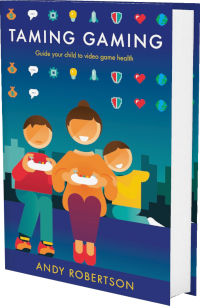 Android
Android iOS
iOS Mac
Mac Switch
Switch Wii
Wii Wii U
Wii U PC
PC PS4
PS4 PS5
PS5 Xbox One
Xbox One Xbox X|S
Xbox X|SWe've documented 29 accessibility features for Last Defense!, including No Pressured Reveals, No Close Inspection Disadvantage, Easily Verbalised Game State, Outline Key Elements and Colour Blind Friendly Design. Its accessibility is strongest in Physical and Difficulty but it also has features in Getting Started, Reading, Visual and Audio to reduce unintended barriers.
This report is created with input from accessibility experts and the player community to help people find games that have the accessibility features they require. Once you have found potential games on the database, there are excellent specialist accessibility sites that offer in-depth reviews to guide your purchasing decisions.
Our accessibility examiner, Andy Robertson, first checked Last Defense! accessibility 20 months ago.
 Accessibility Notes
Accessibility Notes
Your player card displays the steps of playing the game, along with an electronic manual and video in the game's related app. The app provides audio that drives the game but doesn't have subtitles.
Text is generally of good size and contrast. However, the School location lacks contrast with dark green on lighter green. This is also true on some of the character cards, although here the instructional text is always white on dark pink and of good contrast.
 Game Details
Game Details
Release Date: 01/01/2020
Price: 20% off
Skill Rating: 6+ year-olds
Players: 2-6
Genres: Sequencing, Traversal (Collecting, Communication, Race and Strategy)
Accessibility: 29 features
Components: Board, Cards, Dice, Figures and Tokens
Developer: Funko Games (@FunkoGames)
Costs: Purchase cost
 Difficulty
Difficulty
We've documented 5 accessibility features for Difficulty in Last Defense! which deal with how you can adjust the challenge of play.
Difficulty Options
Simple and Full Version: Game provides layered rules to enable the removal of elements for a simpler version of the game. Ideally, these are given non-stigmatising descriptors for example, "simple/complex" rather than "novice/expert".
No Memorisation Advantage: You don’t need to memorise and recall the state of the game, cards played, sequences and resources to play the game well. Players who are able to do this more easily are not at an advantage.
No Deceit Advantage: No game mechanic where players need to deceive each other to progress. This includes bluffing and lying.
No Colour Advantage: Game can be played without colour-blindness being a barrier to performance.
No Mathematics Advantage: Game can be played effectively without doing more than simple counting. It doesn't require calculations or working with large numbers.
 Getting Started
Getting Started
We've documented 5 accessibility features for Getting Started in Last Defense! which deal with what support is offered to get started with the game.
Assistance Getting Started
These features aid your play of the game in terms of cognitive load on learning controls, dealing with pressure and coping with the environment and challenges.
Clear Manual: Game provides a manual that breaks play into number sections, groups information sensibly and uses illustrative pictures.
Electronic Version of Manual: A free online version of the manual provided by the publisher.
Getting Started Video: Game provides a tutorial video to get you started. This video must include subtitles and offer real examples of play.
Reference Aid: In addition to the main rules, a succinct quick reference card is also provided for each player to remind them of key rules, actions and currencies. This may be a separate card or integrated onto the board or cards.
Assistance Progressing
These features aid your progress through the game offering different ways of managing your pieces and progression.
Low Impact: Decisions are low impact. If you get something wrong, you can still make up for it and/or progress another way.
 Reading
Reading
We've documented 5 accessibility features for Reading in Last Defense! which deal with how much reading or listening comprehension is required, how well the game provides accessible text.
Reading Level
How much reading is required to play the game and how complex the language is.
Simple Minimal Reading: Minimal reading is required. The quantity and complexity of reading are at a level that a primary/elementary student (9-year-old) could understand.
Necessary Text Visibility
How clear are the required text or numbers to play the game.
Large Clear Text on Board (Or no text required): Text or numbers are large and clear font at least 8mm tall (22pt) on the board and any other elements that are at a distance to the player.
Large Clear Text on Cards (Or no text required): Text or numbers are large and clear 5mm tall (14pt) on the pieces that you can hold close to read.
High Contrast Text (Or no text required): Text or number colours contrasts to the background. The text in instructions and other information is presented in high contrast ideally with a solid background.
Clear Icons: Icons are used to simply communicate and highlight important graphical elements related to gameplay. This assumes good contrast and generally familiar symbols.
 Physical
Physical
We've documented 9 accessibility features for Physical in Last Defense! which deal with how you interact with the game components and how accommodating these are of different requirements.
Pieces
How the game components accommodate interactions through touch, shape, texture and colour.
No Tiny Pieces: Game pieces are not very small. This doesn't cover cards. The target size for this is not less than 20mm wide and not less than 2mm thick.
No Paper Money: The game doesn’t use paper money.
Cards
How the game assists interaction, manipulation and management of game cards.
Standard Card Shape: Cards confirm to standard size so they work with card shufflers and other card management devices.
Limited Hand Management: You don’t need to hold more than 8 cards in your hand. This includes games with larger hands that require minimal in-hand card management.
No Excessive Card Shuffling: You don’t need to shuffle the deck of cards more than twice per total play of the game. This wouldn’t include games like Poker.
No Right-Handed Advantage: Cards don't position key information in only top-left corners that favours right-handed in-hand card arrangements.
Placement
How the game assists interaction, manipulation, management and placement of game pieces.
Player Components Not Shared: Key components are not shared so you can organise them as best suits your needs. Keeping them close to you. Organising them in useful groupings.
No Fiddly Placement: No movement or manipulation of small pieces or cards in limited space on a board or other location.
Easily Verbalised Actions: The game is clearly labelled (landmarks, coordinates and so on) to make it possible to unambiguously describe game actions and relate those to the board or other pieces. This is useful for players who need others to move their pieces.
 Visual
Visual
We've documented 4 accessibility features for Visual in Last Defense! which deal with how well the game offers visual clarity and adjustments to accommodate visual needs.
Printed Visibility
How well the art on (and design of) components support a range of visual needs.
Colour Blind Friendly Design: Game prioritises the use of colour blind friendly palettes. This eases distinguishing elements of the game where colour is used. Ensure colour blind supporting graphics can be easily described or verbalised.
Component Identifiability
How easy it is to see and identify the components you need to work with to play the game.
Outline Key Elements: Game uses a highly distinctive visual silhouette for essential elements required to play the game. This may be from the shape of game elements or by applying a bold outline or backing colour. It may also be clear text if that is the only pertinent information
Easily Verbalised Game State: Other players can describe the state of both their playing area and shared areas for players unable to see them. The verbalised game state is not too complexed to memorise.
No Close Inspection Disadvantage: If necessary, players can inspect similar pieces to distinguish them without time limit or risk of leaking gameplay intention.
 Audio
Audio
We've documented 1 accessibility feature for Audio in Last Defense! which deals with how the game supports player communication to meet a range of requirements.
Communication
How the game accommodates different styles of communication, particularly non-verbal.
No Pressured Reveals: No reliance on revealing actions or choices simultaneously. This ensures players who can’t perform the revealing action in real-time aren’t excluded.
Similar Games With More Accessibility Features for Audio
If you want to play Last Defense!, but it doesn't offer the Audio accessibility features you require, this similar game extends the Audio accessibility:
- Yarrr Har Hunt (2 Audio Features)
Accessibility Report supported by VSC Rating Board, PlayabilityInitiative and accessibility contributors Andy Robertson












